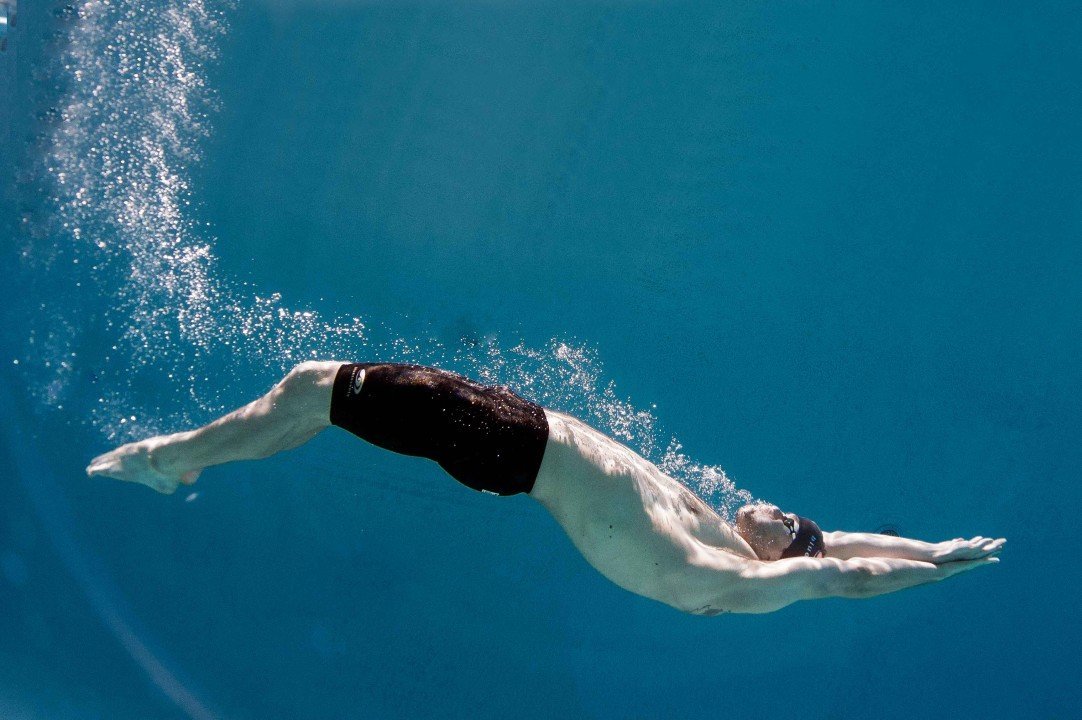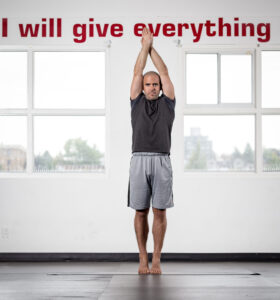Could improving your ankle mobility be the solution to all of your problems?
Probably not, but it will help you develop a stronger kick and a better body position in the water. Have you ever found yourself questioning why all of those hard kick sets don’t seem to produce the results you want to see? Or why it is so difficult for you to keep your legs at the surface even when the rest of your body is in the right position?
These are problems ankle mobility can solve.
By optimizing the range of motion in your ankles you will improve your kicking speed, have the ability to produce more power off your starts and turns and improve your overall body position.
Now that you know what optimizing your ankle mobility can do for your swimming you are probably chomping at the bit to find out how to go about doing it. Be patient I want to give you a little bit more information that will make your journey down this road more effective.
Mobility
The two movements of the ankle we will focus on are:
- Plantar flexion – the top of your foot away from your shin
- Dorsiflexion – raising the foot up towards your shin
For your kick to move you forward you have to apply force in the opposite direction and without adequate ankle mobility that is near impossible.
Plantar flexion are the keys to butterfly, backstroke and freestyle kick while dorsiflexion will make your breaststroke kick more powerful.
Nathan Adrian and Jessica Hardy are great examples of how ankle mobility can make you move through the water in a much more effective and efficient way.
https://www.youtube.com/watch?v=Nl_z_4IGit8
https://www.youtube.com/watch?v=QLcf706sL8U
How to Improve Your Ankle Mobility
The ankle joint is not as simple as you may think. There are typically four reasons your mobility may be restricted:
- Stiffness in the talocrural joint
- Tight muscles tissue and fascia
- Overall ankle strength
- Mobility in the 1st MTP joint of the big toe
The nine poses below take aim at these four areas.
Wind Reliever with Ankle Movement
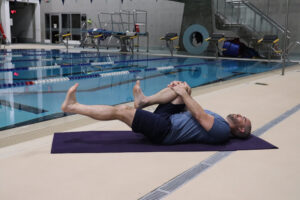
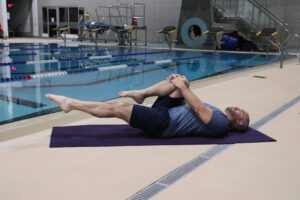
Cues:
- Bring both knees in towards the chest
- Hold onto your left shin
- On an exhale extend your right leg long hovering your heel a few inches above the ground
- Start with the toes of both feet pointed towards the sky and the feet curled back towards your shins
- In this position there are three movements you can do to actively work on the mobility in your ankles:
- On an exhale point your toes and feet away from you and on an inhale curl them back towards your shins
- Draw circles with your feet making sure you move in both directions
- Write the alphabet with your feet
Standing Variation
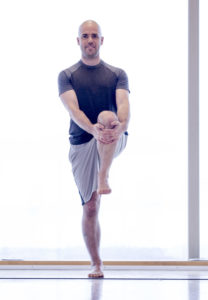
Cues:
- Start in mountain pose
- Feel strongly into the four corners of the right foot
- Put a slight bend in your right knee engaging the quads and glutes
- On an inhale lift your left knee towards your chest
- Hold onto the front of the left shin (or back of your thigh) bringing your left knee towards the chest
- Once in the balance you can do the same movements with the elevated foot:
- On an exhale point your toes and feet away from you and on an inhale curl them back towards your shins
- Draw circles with your feet making sure you move in both directions
- Write the alphabet with your feet
Cat Cow Variation
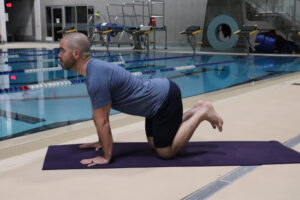
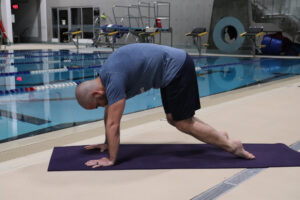
Cues:
- Start in a table top position (on hands and knees)
- On an inhale lift your tailbone, arch your spine, bring your chest and chin forward while bringing your heels towards your seat and curling your toes towards your shins
- On an exhale place the top of your feet down on the ground, drop your tailbone, round your spine, drop your head and press the top of your feet down lifting your knees and stretching the front of the ankles
Kneeling Ankle Stretch
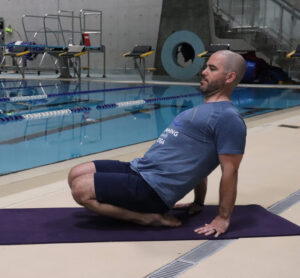
Cues:
- Start in a kneeling position
- Bring your hands back behind you
- Press your sternum forward and keeping a long spine bring your knees off of the ground
- As you bring your knees off of the ground press strongly into the top of the feet
Modified Planche Plank
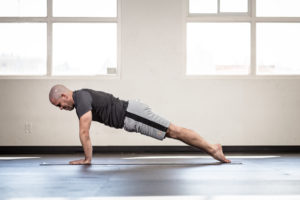
Cues:
- Start in a plank position
- Fingers spread wide and pointed straight forward
- Shoulders over elbows and elbows over wrists
- Externally rotate your shoulders
- Your seat in line with the rest of your spine
- Press the ground away just enough that you feel the shoulder blades strongly on the back
- Slowly bring the top of your feet onto the ground and press into the top of the feet as you stretch the ankle
Standing Streamline with Heel Lifts
Cues:
- Start in mountain pose (a strong standing posture)
- Bring your big toes together and your legs together
- On an inhale bring your arms up and out to the side and then overhead into a streamline position
- Press into the balls of your feet and engage your calves coming up onto your tip toes
Down Dog

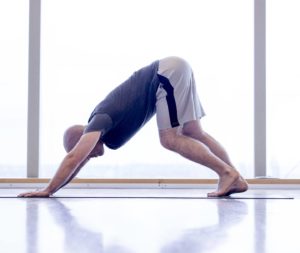
Cues:
- Start in table top (on hands and knees)
- Walk your knees back a few inches
- Externally rotate your shoulders (keeping your fingers pointed forward turn your elbow creases away from you and twirl your triceps towards one another)
- On an exhale press the ground away from you and your hips up and back in a diagonal direction
- Come into an inverted ‘V’ position as you bring your legs towards straight
- Make the priority the length in your spine rather than how straight you can get your legs
- On an inhale bend into your left knee and slowly start to extend the right leg stretching your calves
Pose Alternative – Table Top Calf Stretch
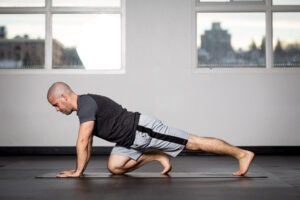
Cues:
- Start in a table top position (hands and knees)
- Extend your left leg back behind you
- Come onto the ball of your back foot and press through your heel stretching your calves
Toe Squat
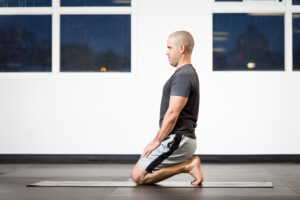
Cues:
- Start in a table top position (hands and knees)
- Have your toes tucked under
- Gradually start to bring your seat back towards your heels eventually sitting on your heels and bringing your torso upright
- Remember work with your range of motion this can be an intense stretch for the toes and the fascia in the bottom of the foot. Come into the pose gradually discomfort is okay, but pain is not.
Low Lunge with Increased Dorsi Flexion
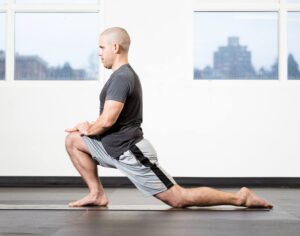
Cues:
- Start in a low lunge position
- Focus on the front leg and not stretching the hip flexors
- Place your hands on your front thigh and gently press down forward into the thigh bringing the knee forward in front of the ankle and towards your toes and possibly past your toes
*To create more range of motion in the front ankle shorten the length of your lunge by bringing the back knee further forward.
Yogi Squat

Cues:
- Start in mountain pose
- Bring your feet to approximately mat distance apart
- Turn your feet out towards a 45°
- On an exhale bring the palms together drawing the hands down through the centre of the body
- At the same time bend your knees and lower the seat towards the ground
- Working with your range come into the appropriate depth of a squat
- Keep your spine long and press your sternum towards your thumbs
- Place your elbows to the inside of your knees or thighs pressing the knees out wide
…
These poses can be done on their own or as part of a yoga class or flow, which you can find below.
…
TO LEARN MORE ABOUT HOW YOGA CAN HELP YOUR SWIMMING PERFORMANCE SIGN UP FOR OUR NEWSLETTER AND JOIN THE SWIMMING-SPECIFIC YOGA COMMUNITY
